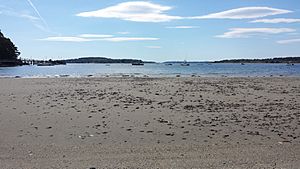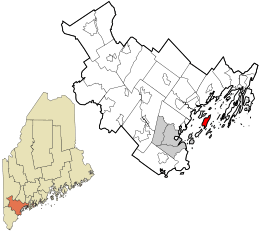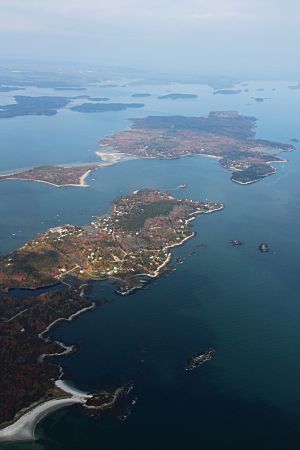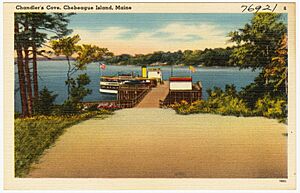Chebeague Island facts for kids
Quick facts for kids
Chebeague Island
|
|
|---|---|

Chandler's Cove beach, looking southwest
|
|

Location in Cumberland County and the state of Maine.
|
|
| Country | United States |
| State | Maine |
| County | Cumberland |
| Incorporated | July 1, 2007 |
| Area | |
| • Total | 24.56 sq mi (63.61 km2) |
| • Land | 3.56 sq mi (9.22 km2) |
| • Water | 21.00 sq mi (54.39 km2) |
| Elevation | 62 ft (19 m) |
| Population
(2020)
|
|
| • Total | 396 |
| • Density | 111/sq mi (43.0/km2) |
| Time zone | UTC-5 (Eastern (EST)) |
| • Summer (DST) | UTC-4 (EDT) |
| ZIP code |
04017
|
| Area code(s) | 207 |
Chebeague Island is a beautiful island located in Casco Bay, which is an inlet of the Gulf of Maine. Long ago, Abenaki Native Americans used this island for fishing. Today, it is a town in Cumberland County, Maine, United States.
Chebeague Island is about 10 miles (16 km) northeast of Portland. It is the biggest island in Casco Bay that you cannot reach by a bridge from the mainland. The largest island in the bay, Sebascodegan, is connected by a short bridge.
Chebeague Island is one of the many islands in the area. In the past, people thought there were as many islands as days in a year! But actually, there are more than 200 islands in Casco Bay.
Until 2007, Chebeague Island was part of the town of Cumberland. On July 1, 2007, it became its own town. The Town of Chebeague Island includes seventeen smaller islands and the waters around them. These include islands like Bangs, Hope, and Stave.
In 2020, about 396 people lived on Chebeague Island all year. But in the summer, the population grows much larger, sometimes tripling!
Contents
Discover Chebeague Island's Past
What's in a Name?
The name "Chebeague" comes from the Wabanaki Confederacy, a group of First Nations and Native American tribes. The most common meaning for Chebeague is "Island of Many Springs." Other ideas suggest it means "cold spring" or "separated," because Great Chebeague Island and Little Chebeague Island are connected at low tide. For a while, Great Chebeague Island was also called Recompense Island.
Early Island Life
Native Americans did not live on the island all year. They came by canoe in the summer to fish and gather shellfish. This food helped them get through the winter months.
The first European settlers arrived later. Zachariah Chandler bought a large piece of land in 1746. Other early families, like Ambrose and Deborah Hamilton, had many children and grandchildren who settled on the island. These early settlers cleared much of the island for farming. Lobsters were so common that people used them as fertilizer for their fields!
Growing Commerce and Tourism
The island's economy first grew around fishing and farming. People also built "stone sloops." These were ships that carried granite from quarries down the eastern seaboard. The granite was used to build things like breakwaters and lighthouses.
In the late 1800s and early 1900s, tourists started visiting Maine. They came from places like Canada and Boston. They wanted to enjoy nature and escape city life. These visitors filled the cottages, rooming houses, and inns, like the Chebeague Island Inn. In 1900, Chebeague Island had five hotels! Tourists arrived by steamboats from Portland.
Community and Education
The Chebeague High School closed in 1956. The old schoolhouse, built in 1871, is now a museum. It helps tell the story of Great Chebeague's history.
The island has a strong community spirit, especially in the summer. Children can join many camps offered by the island's recreation center. Popular camps include farm camp, clown camp, and theater camp. The Chebeague Island Sailing School is also very popular. Students learn to sail small boats and enjoy the waters of Casco Bay.
Island Independence
In 2002, Chebeague Island started thinking about becoming separate from Cumberland. They had been part of Cumberland for 184 years. This idea gained support when the school district thought about making the island's elementary school smaller.
The island finally won its independence. The Maine Senate and House of Representatives voted for it in 2006. The separation officially happened on July 1, 2007.
Chebeague Island's Geography
The town of Chebeague Island covers about 24.56 square miles (63.61 km²). Most of this area, about 21 square miles (54.39 km²), is water. The land area is about 3.56 square miles (9.22 km²).
Chebeague Island is about 3 miles (4.8 km) long and 1 mile (1.6 km) wide. It is the largest island in Casco Bay that is not connected by a bridge. The northern tip of the island is called Chebeague Point. The southern tip is called Deer Point.
Little Chebeague Island
Chebeague Island is sometimes called "Great Chebeague." This is because it is not always a single piece of land. The nearby island of "Little Chebeague" can be reached on foot. A sandbar appears at low tide, connecting the two islands.
Getting Around Chebeague Island
There are two ferry services to the island. The Chebeague Transportation Company (CTC) ferry, the Independence, takes about 15 minutes. It travels from Cousins Island to the Stone Wharf on Chebeague. Casco Bay Lines also provides ferry service.
The island has one main paved road that loops around it. It has different names, like North Road and South Road. There are also smaller paved or partly-paved roads. Many unpaved roads lead to homes and beaches. The beaches are considered public land, so anyone can walk on them.
Some smaller roads are just sandy trails. If two cars meet, one might have to pull over or back up. Most residents have "island cars." These cars can handle the rough roads and the salty air from Casco Bay. Island cars do not need license plates, but they must be registered.
Children who live on the island all year take a boat to the mainland every day for middle and high school. Younger children (kindergarten to 5th grade) go to school on the island.
Wildlife and Nature on Chebeague
You can see many animals on Chebeague Island. These include deer, red foxes, raccoons, and squirrels. There are also different kinds of non-venomous snakes, frogs, and toads. Birds like gulls, loons, and ducks are common. Interestingly, there are no skunks on the island! Mosquitoes can be a problem because the island has soft, sandy, swampy soil, which is perfect for them to breed.
You can often spot Harbor seals from the shore. They swim or sunbathe on rocks or buoys. Sometimes, you might even see a porpoise pop out of the water.
Lobstering is a big part of life in Casco Bay. The ocean around Chebeague is full of thousands of lobster pot buoys. This is how many year-round residents make their living. Locals also fish from the docks for mackerel, bluefish, or striped bass. Crab traps also hang from the docks.
Blueberry Patches
Like much of Maine, Chebeague Island has many blueberry patches. Locals love to pick the abundant blueberries. However, these patches are slowly getting smaller as more land is developed.
Clamming and Red Tide
The many coves around the island have lots of clam beds. At low tide, these areas are exposed. Locals often go clamming for steamers, hen clams, and razor clams.
Sometimes, clamming is stopped because of "red tide." This is caused by tiny ocean organisms that can harm shellfish. Eating clams affected by red tide can make people very sick. It can even be deadly.
For many years, mussels were not eaten much. But in the 1980s and 1990s, when clams became harder to find, mussels became popular. Mussels are easier to collect than clams. Clams have to be dug out of the sand by hand, which is hard work. Mussels attach to rocks on the shore, so you can collect a bucketful in minutes. Today, many mussels are "farmed" on floating barges.
Ocean and Weather
Chebeague Island usually has tides that rise and fall about 8 to 9 feet (2.4 to 2.7 meters). The ocean floor can change a lot, so boats need to be careful. Many islands have rocks that are underwater at high tide but appear as the tide drops. Strong currents, called rip tides, can also be dangerous for small boats. Even on a clear day, a thick fog can suddenly appear, making it impossible to see.
Even in the warmest summer months, the ocean water is usually cool, just above 60°F (15°C). Falling into the water between September and April can be very dangerous. People usually swim in coves where the water is a bit warmer, or off the piers.
Like most islands in the area, Chebeague has rocky cliffs and beaches. The "Niblic" beach and Deer Point are popular for their soft sand. On a clear day from Deer Point, you can see Mount Washington in New Hampshire.
Even on warm summer days, nights can get very cool. Winters on the island can be very harsh. Most seasonal residents leave by September.
Island Services and Stores
Chebeague Island has its own post office and cell phone service. The Town of Chebeague Island has a website with town documents and a calendar.
There is one school on the island for Pre-K through 5th grade. Students in 6th grade and older go to schools on the mainland. They attend Frank H. Harrison Middle School and Yarmouth High School.
The Chebeague Island Boatyard offers many services. These include boat storage and engine repairs. In the summer, a gift store called the Niblic is open at the Boatyard.
The Chebeague Island Methodist Church is the oldest organization on the island. It has been there since the 1700s. Today, the church is led by Chaplain Victor Diaz.
The local historical museum, run by the Chebeague Island Historical Society, is open in the summer. The Chebeague Island Library is open all year.
Second Wind Farm provides islanders with fresh, locally-grown produce during the growing season.
The Chebeague Island Inn and its restaurant are open in the summer. There is also a nine-hole golf course, a tennis club, and two gift shops.
The island has a full-time volunteer fire station and EMTs (Emergency Medical Technicians) with an ambulance. Police matters are handled by Cumberland County Sheriff officers. For medical emergencies, people are taken to the mainland by ambulance and ferry.
Notable People from Chebeague Island
- David Dodd, an educator and financial expert.
- Raymond Gilmartin, former CEO of Merck & Co.
- Ellen Goodman, a Pulitzer Prize-winning newspaper columnist.
See also
 In Spanish: Chebeague Island para niños
In Spanish: Chebeague Island para niños





